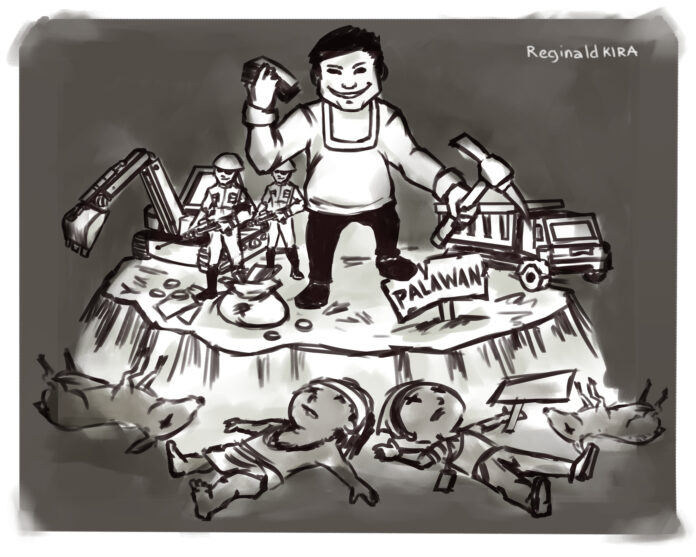A couple of weeks ago the foreign news channel Russia Today (RT) released a mini documentary about the island of Palawan entitled, Palawan Lost.
One of the most visited islands not only in the Philippines but in the entire Southeast Asia, Palawan is loved for its captivating beaches, breathtaking marine life, and charming archipelago of tiny islands. Every year Palawan hosts thousands of visitors, foreign and local, making it one of the busiest islands in the country. But the RT documentary presents a different reality of Palawan — one that is unpopular and hidden from the public, a reality to which the mainstream media offer either a customary silence or a passing remark.
Palawan is a territory which is extraordinarily fertile, imbued with a diverse wealth of natural resources which makes it prey to rapacious mining companies and to greedy high officials. As a result of this institutional rape and plunder environmental activists are being killed like flies. The documentary quotes that second to Brazil the Philippines rates as the most dangerous place for environmental activists. The research group Global Witness documented that in “41 of the 67 cases… the activists killed were opponents of large-scale mines by both international and domestic mining companies.” And what is even more enraging is the culture of impunity which “the vast majority of perpetrators appear to enjoy… due to the weakness of the judiciary and law enforcement agencies. Allegations of security service involvement are a feature of many cases.”
The death of the activist and journalist Gerry Ortega in 2011 was linked to his exposure of high officials in the provincial government of Palawan “for the unconstitutional, illegal and anomalous arrangement with respect to the Malampaya funds (the Malampaya Natural Gas and Oil Field Project).”
The verdant territories of indigenous peoples on which they depend for their physical subsistence and cultural sustenance are where most of the mining and illegal logging activities are situated. It is in these devastated indigenous territories that one can witness the viciousness of mining companies and the immoral character of capitalism. While mining companies enjoy low taxes, impunity, political power, and colossal profits, the indigenous peoples carry all the burdens of a wrecked environment. Landslides, soil erosion, polluted water resources, deforestation, etc. The UK-based Working Group on Mining in the Philippines reported:
“Mining creates fewer jobs per unit of money invested and contributes least to poverty reduction and sustainable development. On the contrary, it often increases poverty… Profits of mining are privatised by companies, while costs are externalised to Filipino communities, the legacy remaining long after the mining corporation has left the country… Mining is also frequently associated with generating or exacerbating conflicts, militarisation, human rights abuse and corruption in the Philippines.”
Palawan is one of the many cases in the Philippines in which government-backed companies are encouraged to pillage and rape the natural resources without least consideration of the unbearable cost to the indigenous peoples. The case of the Lumads in Mindanao is an extreme case. The documentary is subtitled, The dark side of a tropical idyll that tourists don’t see. This is the tragedy of the many tourist spots in which indigenous people are living. Tourism successfully hides the ugly reality from public scrutiny. Indigenous peoples are forced out of their lands to pave way for resorts, hotels, mansions, and mining. A native of Palawan lamented:
“Time will come when our children no longer recognize the names of trees, the footprints of animals, the birds’ songs. This will be the time when the forest is gone, the mining companies are gone, the rivers no longer flow.”
It is alarming that a foreign news channel should produce a documentary about the condition of our indigenous peoples while our national media play safe. There should be studies of indigenous culture in our media, in educational institutions, in discussions and talks, in national debates. Indigenous cultures with their age-old remedies are crucial to the various crises we are facing today. The excessive materialism we have adopted from the West is proving to be disastrous from all directions. From depression, meaninglessness, insecurity, and boredom among the younger generation to political barbarity motivated by the pursuit of power to economic crisis brought by neoliberalism to the irreversible environmental catastrophe the recognition of indigenous culture might guide us to a better direction. As Antiso Mandawa, chairman of the ALDAW network (Ancestral Land/Domain Watch), said, “Indigenous peoples have been the guardians and stewards of these precious natural and cultivated resources over a long period of time.”
Indigenous resistance challenges us to rethink our values, behaviors, and economic structures that are set on destroying this already devastated planet.
Carlo Rey Lacsamana is a Filipino, born and raised in Manila, Philippines. Since 2005, he has been living and working in the Tuscan town of Lucca, Italy.
































